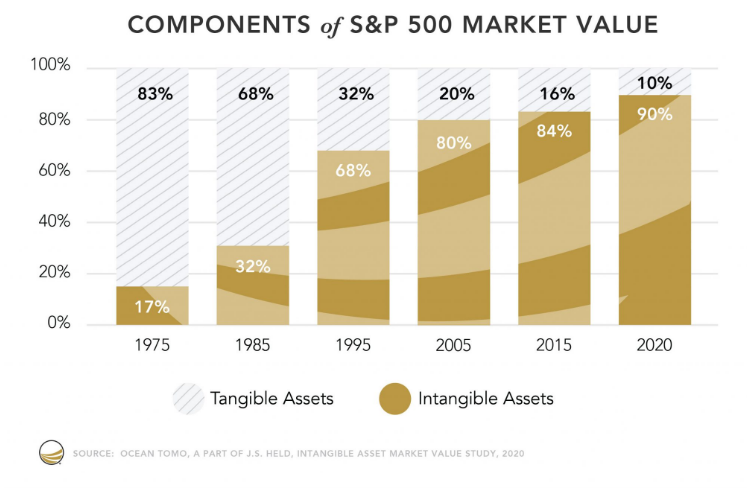Executives in boardrooms worldwide are facing a striking paradox. They're steering companies built on intangible assets—algorithms, data, code, and machine intelligence—yet relying on valuation frameworks forged in the industrial era. This situation is akin to trying to appraise a quantum computer using a slide rule, underscoring the urgent need for rethinking IP valuation.
The emergence of generative AI, machine learning, and scalable digital platforms has pushed intellectual property (IP) beyond traditional boundaries. It no longer sits neatly within patent portfolios or software registries. Instead, IP is embedded in data pipelines, hidden in training sets, and multiplied through user ecosystems.
If your valuation models don't reflect this shift, you're not just underestimating assets—you're misjudging the very foundation of your business.
The stark reality is that most corporate value is now invisible in the digital age, underscoring the critical need for new valuation methods. Let's start with a fact that should give any CFO pause. According to the latest Ocean Tomo Intangible Asset Market Value Study, 90.1% of the S&P 500's market value in 2020 was derived from intangible assets—up from just 17% in 1975.

Three Reasons the Valuation Playbook is Broken
1. AI Doesn’t Just Generate Value—It Multiplies It
AI systems aren’t linear in their output. They improve with every iteration, dataset, and user feedback loop. That evolution—whether in fraud detection algorithms or personalized drug discovery engines—is part of the asset. Static models miss this compounding effect.
Case in point: OpenAI’s valuation jumped from $14 billion in 2021 to over $80 billion by late 2023, primarily based on its GPT models’ scalability and reinforcement learning capabilities.
2. Data is the New IP—But Try Finding it on a Balance Sheet
Generative AI isn’t magic. Its power lies in the quality, structure, and exclusivity of the data it’s trained on. These training datasets are rarely patented or trademarked but are often the most valuable part of the IP stack.
McKinsey estimates that companies integrating AI and proprietary data effectively can boost their EBITDA by 20–25%.
3. IP No Longer Lives in Isolation
Today’s innovation rarely emerges from a single invention. It lives in ecosystems—an AI model here, a custom interface there, cloud integration everywhere. Valuation models that ignore synergy, interoperability, and network effects are no longer fit for purpose.
In Microsoft’s $19.7B acquisition of Nuance in 2021, the real prize wasn’t patents—it was Nuance’s AI-enabled healthcare transcription models trained on 10 billion medical interactions.
What Gets Missed—and Why It Matters
|
Ignored Element
|
Why It’s Critical
|
|---|---|
|
Training datasets
|
Foundation for differentiated AI capability
|
|
Algorithm refinement cycles
|
Determines future performance, not just current state
|
|
Interoperability across assets
|
Drives platform dominance and licensing opportunities
|
|
Speed of obsolescence
|
Impacts lifespan and renewal strategy
|
The result? Deals undervalue key IP, investors misread risk, courts struggle to assign damages, and business leaders make strategic decisions based on distorted pictures of enterprise worth.
Building a 21st-Century IP Valuation Framework
To align IP valuation with today’s innovation dynamics, executives should urgently embrace a new methodology:
- Think in Systems, Not Silos
Valuation should span data assets, machine learning models, process know-how, and embedded software, not just formal IP filings. - Quantify Learning Loops
If your model improves through use, its future state will be more valuable than its current one. Bake learning velocity into your projections. - Map Ecosystem Impact
Your AI tool might not sell directly—but if it enhances platform stickiness or shortens go-to-market by 40%, that impact is real, quantifiable, and monetizable. - Adjust for Obsolescence
AI ages like milk, not wine. A robust model today could be surpassed in months. Discount rates must reflect this volatility.
So, How Do You Implement This?
Bridging the gap between intangible value and actionable valuation starts with three practical steps:
- Inventory the Unseen
Begin by mapping all value-generating assets—structured and unstructured data, code repositories, ML pipelines, domain expertise, and proprietary algorithms—and linking them to business outcomes.
Evalueserve’s IP and R&D team offers dedicated IP audit services that help companies uncover overlooked innovation assets, which are critical in forming a complete valuation picture.
- Adopt Dynamic Valuation Models
Use forward-looking approaches that account for learning velocity, ecosystem synergies, and renewal strategies. Static cost-based models fail to capture this momentum.
Evalueserve leverages hybrid valuation methodologies, combining market, income, and cost-based insights with AI-specific parameters to deliver robust, litigation-ready valuations.
- Collaborate Across Legal, R&D, and Finance
Valuation isn’t just for finance teams. It requires input from legal, tech, and product leaders to capture asset use cases and risks.
Our cross-functional IP valuation consultants work with clients to bridge legal defensibility with strategic and commercial impact.
Final Thought: You Can't Price What You Don't Understand
IP valuation is no longer just a finance function. It's a strategic capability that bridges legal, technical, and commercial domains. In a time when your algorithm may be more valuable than your product, relying on outdated methods is not just inefficient—it's reckless.
Leaders who can decode, articulate, and monetize their innovation infrastructure will not just define but drive the next era of business growth. Everyone else will be guessing.
Talk to One of Our Experts
Get in touch today to find out about how Evalueserve can help you improve your processes, making you better, faster and more efficient.


